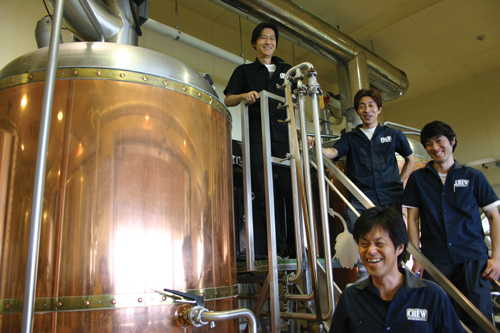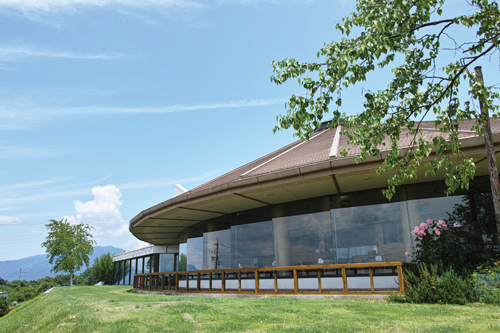by Kumagai Jinya

You could say there are many breweries in Nagano Prefecture, but when you consider that among all 47 prefectures it is the fourth largest, maybe that’s not so strange. Nagano is rather long, from north to south, with four major regions: Hokushin, Chûshin, Nanshin, Tôshin. The climates of each are slightly different. In the eastern region of Tôshin where you have the cities of Ueda, Tômi, Komoro and Saku, rainfall is relatively low, sunshine high, and wind infrequent, making it an appropriate place for hop cultivation. In fact, it is the main growing area for Shinshuwase, a variety of hop developed in the prefecture. And in Tômi you’ll find the brewery for OH! LA! HO! Beer.
The brewery’s origins date back to the Tôbu-machi Development and Promotion Corporation (a public-private joint venture), which was established July 1st, 1994. This parent company began operations in a corner of Tôbu-machi, primarily running Yurarikan, a day-trip hot spring facility, in those early days. Thereafter, the company began looking into the beer business. Then on July 21st, 1996, just twenty days after Nagano’s famous Minami Shinshu Beer launched, it assumed the name Tôbumachi Ji-Beer Club and began the production and sale of OH! LA! HO! Beer. In 2004, when Tôbu-machi and Kitamimaki-mura merged to form Tômi, the company changed its named to Shinshu Tômishi Public Corporation.
The original head brewer, Kobayashi Ryôji, is now the corporate director. Kobayashi studied brewing at the Tokyo University of Agriculture, and when the company’s brewing project launched, he responded to a recruitment call, thinking, “I wonder if my brewing skills would be of any use?” After joining the company, he trained in both Seattle and at Sumidagawa Brewing, which is a craft beer division of Asahi Beer. Three months after opening, an American technical adviser came over as well. He was Ed Tringali, who helped both Minamishinshu and Swan Lake with their launches (we featured Ed in issue #8, and Swan Lake’s “Pub Edo” is also a pun on “old Tokyo” and his name in Japanese phonetics).
The brewery started with three flagship beers, a golden ale, an amber ale and a porter. As soon as it opened, Tôbumachi Ji-Beer Club flourished. Takizawa Kenichirô who is now the general manager of both OH! LA! HO! Beer and the attached restaurant was just a restaurant floor staff at the time. “From the time we opened until the last order at 10pm, we basically had to pour beer non-stop or we couldn’t fill the orders―it was booming that much.” In January of the following year, 1997, they began selling one liter bottles, and in May, cans. Their beer production then surpassed 100 kiloliters. TV crews came from as far away as Iwate prefecture and its popularity was skyrocketing. But the next year, and then again the next, production began to sag. After a few years of that continued trend, things got dire.
Many say the low point for craft beer production in Japan was 2003. That following year, the current brewmaster, Yamakoshi Takashi, joined the company. Along with Kobayashi, the pair continued to make beer, but in 2006, Kobayashi retired from his post and Yamakoshi took over. Unfortunately, this was the worst year ever for OH! LA! HO! in terms of production volume. The beer business had faltered and they couldn’t seem to find any way out of their predicament.
Earlier, in 1999, OH! LA! HO! had begun winning awards in the Asia Beer Cup and other international competitions. Kobayashi and Yamakoshi had finally achieved consistent quality in their beers. The problem was, this didn’t seem to have any effect on their bottom line. People still continued to perceive it as “some public-private joint venture souvenir beer.”
Totsuka Masaki then joined the company with a mission to lift them from that situation. He first stressed, “We have to work face to face with the customer. When customers are drinking a truly delicious beer, their eyes light up. I think we need to see that for ourselves and think very carefully about what kind of beer we should be making.” They then began participating actively in events and also trying to describe the appeal of their beers to each and every customer.
A beer maker’s customers are not only the ones drinking all the time. There are bottle and can retailers, too. A few of them have had some choice words for the brewery. The operator of one retailer in Nagano that carries a variety of beers said, “Do they even care about brewing?” Now that the brewery has gotten its act together, however, he says, “They’re good now, aren’t they?”
Once they started approaching their customers and taking their brewing more seriously, they slowly but steadily began to see an increase in orders for their kegs from beer bars. Says Totsuka, “In addition to bar owners recognizing our improved taste, we’ve also heard talk of customers who love our beer convincing bar owners to carry it.” At present, their production volume is picking up again, too.
All the employees of OH! LA! HO! seem to say in unison that teamwork counts for much. “For example, anybody can present a new idea for beer. Everyone then participates in the shaping of that idea until the beer becomes an actual product.” Totsuka, who has become the head of business operations, has some brewing experience and has even designed some of the recipes. In this collective spirit, their uniforms are emblazoned with “Brew Crew” and “Brewing Team.”
“In a crisis you can’t really take the scenic route. You have to take the shortest path back to success. To achieve that, we all took responsibility for the business. And to decide what you have to do, you need to gather information,” says Totsuka. The best information comes from customers.
Listening to customers can be valuable in creating new products. In the world of product creation, this seems obvious. Among Japanese craft beer makers, there are probably many that follow this. But the first to really listen to customers to this extent was OH! LA! HO! It’s precisely because they hit rock bottom and nevertheless managed to get back on their feet that you sense such spirit in their endeavor.
There are probably more than a few brewers that can say the same, but their production pace so far this year indicates they will smash last year’s volume. Since last summer, OH! LA! HO! has continued to increase production by between 20 and 30%. Kegs in particular are flying out the doors, also outpacing this same period last year by more then 30%. OH! LA! HO! has begun making seasonals on a regular basis as well. This has been important in beer bars taking a greater interest in them.
Their line-up now includes four regular beers and two seasonals. Yamakoshi laughs, “We initially had trouble selling some, but now our troubles have shifted to maintaining quality while meeting the increasing demand.”
There are actually more than a few examples of special public-private joint businesses launching beer operations. Generally speaking they are second-rate tourist beers people drink to commemorate traveling to that particular area. And while that may be the case, the clean finish of OH! LA! HO!’s beers are really something you should try to experience there.
Also, a public-private joint venture can’t just squander its profits (which creates quite an issue, actually). It has to play a role in stimulating the region and providing a place for locals to gather. In the case of a beer maker, if it doesn’t exactly delight local residents with its taste, then it may just shut down. It’s very different from the responsibility of the average business in making beer. It’s more akin to what you often see in Germany, where in actuality it’s not just a beer you drink in that town, but a beer of the town. That’s OH! LA! HO!

This article was published in Japan Beer Times # () and is among the limited content available online. Order your copy through our online shop or download the digital version from the iTunes store to access the full contents of this issue.



